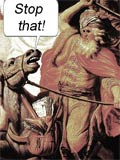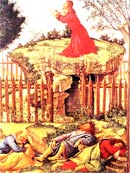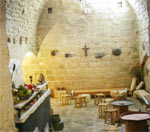Discuss the world's favourite imaginary friend on the JNE YouTube channel
The name Jesus is actually a 16th century creation.
"Jesus" has its origins in יהושוע (Yehoshua or Joshua) in which the first part "yeho" refers to God. The name means "YHWH helps". But it was a name to be used with care and to prevent accidental voicing of the name of God, Yehoshua got truncated to ישוע (Y'shua), or, in the Galilee, to Yeshu.
Transliterated into Greek, Yeshu became Ἰησοῦς (Iesous), and from that, the Latin Iesus. A late development was the letter J which was then substituted for the initial capital I rendering Iesus into Jesus.
Artificial
'The Jesus of the Gospels is an artificial creation, a collective work of art who evolved through the combined consciousness of two generations of Christian worship.'
– A. N. Wilson (Paul, p144)
No Evidence
''Whether Jesus ever actually existed has long been debated. The argument (very well documented) is that there is absolutely no corroborating evidence of his existence in documents other than highly suspect Christian sources.'
– Riane Eisler (The Chalice & the Blade, p122)
Non-Christian Testimony?
Not even born in 30 AD:
Josephus – c 37 - c 100 AD
Tacitus – c 55 - c 117 AD
Suetonius – c 69 - 140 AD
Chrestus?
"Christian defenders like to cite a passage in Suetonius that refers to someone named 'Chrestus' as a reference to their Savior; however, while some have speculated that there was a Roman man of that name at that time, the name 'Chrestus' or 'Chrestos' meaning 'useful' was frequently held by freed slaves."
– Acharya S.
Not a Word
"There's hardly a word of Jesus that is not to be found in a parallel saying of the rabbis."
- Mark Tully (Lives of Jesus, p80)
Ancient Prototype
Take a peek:
"Holy Family"
– in Luxor 1700 BC!
As the Earth rotates, stars will appear to spin around the star most nearly in a direct line with the axis of the Earth's rotation.
(In the northern hemisphere that's the star Polaris. In the southern hemisphere a rough equivalent is the star Sigma Octantis.)
So, other than chasing off towards the pole, Messiah hunters – if they could keep up – would traipse around in a giant circle.
Better go for the comet theory...
'Born under star' from soothsayer with talking donkey!
And if you've ever wondered where the "born under a star" nonsense began it actually comes from the mouth of an Arab wizard supposedly hired to curse the Israelites.
"And Balaam said unto the ass, Because thou hast mocked me: I would there were a sword in mine hand, for now would I kill thee.
And the ass said unto Balaam, Am not I thine ass, upon which thou hast ridden ever since I was thine unto this day? was I ever wont to do so unto thee? And he said, Nay."
– Numbers (22.29,30)
A little later Balaam utters the words wrenched out of context centuries later by Christian novelists:
"And Balaam said unto Balak ... there shall come a Star out of Jacob."
– Numbers (24.12,17)
Regarded as Fraudsters Even in the 2nd Century:
''Clearly the Christians have used ... myths ... in fabricating the story of Jesus' birth'…It is clear to me that the writings of the Christians are a lie and that your fables are not well-enough constructed to conceal this monstrous fiction."
– Celsus (On The True Doctrine, c 178 AD)
In the Land of Nod
Disciples sleep, Jesus communes with God, so just who is taking notes?
Did the Rabbis Know Jesus?
The earliest rabbinic writings make no mention of the Christian godman.
Only when Christianity became a serious challenge to Judaism did the rabbis start to manufacture black propaganda of their own.
St Paul even had a friend called "Jesus"!
"My fellow prisoner Aristarchus sends you his greetings, as does Mark, the cousin of Barnabas ... Jesus who is called Justus also sends greetings.
These are the only Jews among my fellow workers for the kingdom of God, and they have proved a comfort to me."
– Colossians 4.10,11.
Last word
"I sought him but found him not."
– Song of Solomon, 3.1.
Was there a Jesus? Of course there was a Jesus – many!
Josephus, the first century Jewish historian mentions no fewer than nineteen different Yeshuas/Jesii, about half of them contemporaries of the supposed Christ! In his Antiquities, of the twenty-eight high priests who held office from the reign of Herod the Great to the fall of the Temple, no fewer than four bore the name Jesus: Jesus ben Phiabi, Jesus ben Sec, Jesus ben Damneus and Jesus ben Gamaliel. Even Saint Paul makes reference to a rival magician, preaching ‘another Jesus’ (2 Corinthians 11,4). The surfeit of early Jesuses includes:
Jesus ben Sirach. This Jesus was reputedly the author of the Book of Sirach (aka 'Ecclesiasticus, or the Wisdom of Jesus the Son of Sirach'), part of Old Testament Apocrypha. Ben Sirach, writing in Greek about 180 BC, brought together Jewish 'wisdom' and Homeric-style heroes. Jesus ben Pandira. A wonder-worker during the reign of Alexander Jannaeus (106-79 BC), one of the most ruthless of the Maccabean kings. Imprudently, this Jesus launched into a career of end-time prophecy and agitation which upset the king. He met his own premature end-time by being hung on a tree – and on the eve of a Passover. Scholars have speculated this Jesus founded the Essene sect. Jesus ben Ananias. Beginning in 62AD, this Jesus had caused disquiet in Jerusalem with a non-stop doom-laden mantra of ‘Woe to the city’. He prophesied rather vaguely:
Jesus ben Saphat. In the insurrection of 68AD that wrought havoc in Galilee, this Jesus had led the rebels in Tiberias ("the leader of a seditious tumult of mariners and poor people" – Josephus, Life 12.66). When the city was about to fall to Vespasian’s legionaries he fled north to Tarichea on the Sea of Galilee. Jesus ben Gamala. During 68/69 AD this Jesus was a leader of the ‘peace party’ in the civil war wrecking Judaea. From the walls of Jerusalem he had remonstrated with the besieging Idumeans (led by ‘James and John, sons of Susa’). It did him no good. When the Idumeans breached the walls he was put to death and his body thrown to the dogs and carrion birds. Jesus ben Thebuth. A priest who, in the final capitulation of the upper city in 69AD, saved his own skin by surrendering the treasures of the Temple, which included two holy candlesticks, goblets of pure gold, sacred curtains and robes of the high priests. The booty figured prominently in the Triumph held for Vespasian and his son Titus.
But was there a crucified Jesus? Certainly. Jesus ben Stada was a Judean agitator who gave the Romans a headache in the early years of the second century. He met his end in the town of Lydda (twenty five miles from Jerusalem) at the hands of a Roman crucifixion crew. And given the scale that Roman retribution could reach – at the height of the siege of Jerusalem the Romans were crucifying upwards of five hundred captives a day before the city walls – dead heroes called Jesus would (quite literally) have been thick on the ground. Not one merits a full-stop in the great universal history.
The problem for this notion is that absolutely nothing at all corroborates the sacred biography and yet this 'greatest story' is peppered with numerous anachronisms, contradictions and absurdities. For example, at the time that Joseph and the pregnant Mary are said to have gone off to Bethlehem for a supposed Roman census, Galilee (unlike Judaea) was not a Roman province and therefore ma and pa would have had no reason to make the journey. Even if Galilee had been imperial territory, history knows of no ‘universal census’ ordered by Augustus (nor any other emperor) – and Roman taxes were based on property ownership not on a head count. Then again, we now know that Nazareth did not exist before the second century.
It is mentioned not at all in the Old Testament nor by Josephus, who waged war across the length and breadth of Galilee (a territory about the size of Greater London) and yet Josephus records the names of dozens of other towns. In fact most of the ‘Jesus-action’ takes place in towns of equally doubtful provenance, in hamlets so small only partisan Christians know of their existence (yet well attested pagan cities, with extant ruins, failed to make the Jesus itinerary). What should alert us to wholesale fakery here is that practically all the events of Jesus’s supposed life appear in the lives of mythical figures of far more ancient origin. Whether we speak of miraculous birth, prodigious youth, miracles or wondrous healings – all such 'signs' had been ascribed to other gods, centuries before any Jewish holy man strolled about. Jesus’s supposed utterances and wisdom statements are equally common place, being variously drawn from Jewish scripture, neo-Platonic philosophy or commentaries made by Stoic and Cynic sages.
Invisible Friend 'Jesus of Nazareth' supposedly lived in what is the most well-documented period of antiquity – the first century of the Christian era – yet not a single non-Christian source mentions the miracle worker from the sky. All references – including the notorious insertions in Josephus – stem from partisan Christian sources (and Josephus himself, much argued over, was not even born until after the supposed crucifixion). The horrendous truth is that the Christian Jesus was manufactured from plundered sources, re-purposed for the needs of the early Church. It is not with a human being that the Jesus myth begins. Christ is not a deified man but a humanised god who happened to be given the name Yeshu. Those real Jesuses, those that lived and died within normal human parameters, may have left stories and legends behind, later cannibalised by Christian scribes as source material for their own hero, but it is not with any flesh and blood rebel/rabbi/wonder-worker that the story begins. Rather, its genesis is in theology itself.
CNN in the Garden of Gethsemane? Is it unreasonable to ask just who recorded not only one of the last prayers of the godman but also the last occasion when the "living" superhero was with his acolytes? The only possible witnesses were asleep.
Makes You Think Many elements
of the 'Passion' make no sense historically. And why would the Romans have allowed a convicted felon to be almost immediately removed from his cross and put in a tomb? Crucifixion was chosen precisely to make a public point that the most cruel and humiliating form of punishment awaits those who oppose Rome's will. Roman disposition on this point was perhaps best summed up by Quintilian (AD 35-95, Decl. 274) when he wrote that:
But of course if the 'Passion' were really a pageant of a re-born sun-god it makes perfect sense that the 'sacrificed' actor be taken off-stage, subsequently reappearing in a later act, 'reborn'…
PS: High Priest John kills his brother "Jesus" in the Temple! Yet another Jesus was slain – in the holy temple no less – during the reign of Artaxerxes I of Persia (circa 465-424 BC). His brother John, the High Priest, did the dirty deed. Writes Josephus:
Sources:
Copyright © 2004
by Kenneth Humphreys.
|
|||||||||||||||||||||||||||||||||||||||||||||||||||||||||||||||||||||







